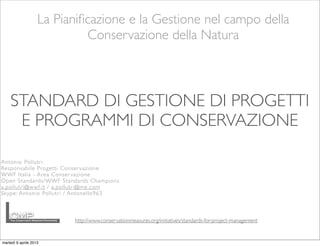
Selezionare i Target di Biodiversità [Standards internazionali per la Conservazione]
- 1. La Pianificazione e la Gestione nel campo della Conservazione della Natura STANDARD DI GESTIONE DI PROGETTI E PROGRAMMI DI CONSERVAZIONE Antonio Pollutr i Responsabile Progetti Conser vazione WWF Italia - Area Conser vazione Open Standards/WWF Standards Champions a.pollutr i@wwf.it / a.pollutr i@me .com Skype: Antonio Pollutr i / Antonello963 http://www.conservationmeasures.org/initiatives/standards-for-project-management martedì 9 aprile 2013
- 2. SCOPO DEL PROGRAMMA Aumentare la capacità gestionale per realizzare una Conservazione più efficace. Promuovere la definizione ed implementazione di interventi che mettono a fuoco e affrontano le priorità più urgenti e le strategie più efficaci. martedì 9 aprile 2013
- 3. AGENDA DELLA PRESENTAZIONE I B ERSAG L I DI B I O D I VE R S ITA ’ (B IOD IV E RS ITY TA R G E T S ) •Cosa sono •Perch é s o n o u t i l i •Come si scelgono martedì 9 aprile 2013
- 4. COSA SONO I TARGET • Una Riserva naturale, un SIC di solito contengono all’interno dei confini decine e, occasionalmente, centinaia di ricorrenze di specie, habitat e comunità. • Bersagli di biodiversità (o Biodiversity Targets) sono gli habitat, le specie, le comunità ecologiche, gli ecosistemi su cui un progetto sceglie di concentrarsi. • I Target dovrebbero essere capaci di rappresentare, cumulativamente, tutta la biodiversità dell’area di progetto. Conservare i Target non è l'obiettivo finale, ma un mezzo per conservare tutta le biodiversità originaria di un’area. • Secondo gli esperti 8 è il numero massimo di Target che un progetto può gestire senza eccessivi rischi di fallimento. martedì 9 aprile 2013
- 5. COSA SONO I TARGET Componenti della biodiversità di un sito/ area, selezionati allo scopo di concentrare gli interventi e monitorare i progressi. Tipicamente i target rappresentano i motivi per i quali un area è stata valutata di importanza conservazionistica martedì 9 aprile 2013
- 6. PERCHÉ SCEGLIERE TARGET GESTIONALI • -Aiutano a zonizzare l’area in ambiti spaziali d’intervento più specifici • -Aiutano a sviluppare strategie più focalizzate • -Sono utili per identificare e selezionare indicatori di successo del piano o progetto martedì 9 aprile 2013
- 7. CATEGORIE DI TARGET • Habitat / Ecosistemi / Biocenosi • Specie cd. Focali (Focal Species) • Processi ecologici martedì 9 aprile 2013
- 8. CARATTERISTICHE DEI TARGET • Il set di target copre la biodiversità dell’area. • Sono in uno stato che può essere realisticamente migliorato • Sono impattati da Minacce critiche. martedì 9 aprile 2013
- 9. SELEZIONE DEI TARGET Elencare tutti i Target potenziali Prendere in considerazione dapprima ambienti, ecosistemi, habitat, specie “ombrello”, specie bandiera Aggregare ai primi, se possibile: fitocenosi, biotopi, raggruppamenti di specie legate allo stesso ecosistema per esigenze simili, specie di particolare interesse conservazionistico, specie chiave ecc. Verificare la posizione di elementi che hanno esigenze speciali di conservazione o che potrebbero non beneficiare o beneficiare in modo parziale della conservazione dei primi Selezionare non oltre 8 target martedì 9 aprile 2013
- 10. SELEZIONE DEI TARGET martedì 9 aprile 2013
- 11. PRODOTTO DI UNA SELEZIONE DI TARGET martedì 9 aprile 2013
- 12. OUTPUT DEL PROCESSO • Una lista dei target accompagnati dalla descrizione di attributi: distribuzione (localizzato, diffuso), stato di conservazione (minacciato, in pericolo d'estinzione), rarità, endemicità, mobilità ecc. • Possibilmente una mappa della distribuzione spaziale dei target • Un documento di descrizione delle eventuali carenze conoscitive per specifici target e/o aree martedì 9 aprile 2013
- 13. RISORSE In inglese: • Manuale Open Standards CMP https://docs.google.com/file/d/0B5xQt-iGgglVaG1KMk52dWtYSTQ/edit?usp=sharing • Manuale Standard WWF Internazionale https://docs.google.com/file/d/0B5xQt-iGgglVclNJWklwZ2ZWS2M/edit?usp=sharing •Miradi https://miradi.org/ In italiano: •Come conseguire risultati di conservazione applicando l’approccio della gestione adattativa https://docs.google.com/file/d/0B5xQt-iGgglVS19SekYzWDRVd1E/edit?usp=sharing martedì 9 aprile 2013
- 14. FINE martedì 9 aprile 2013
